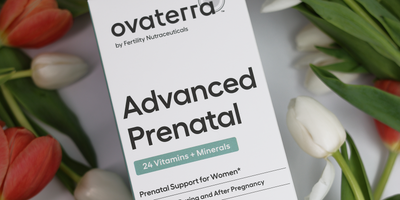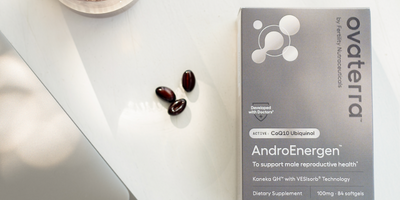It’s winter solstice today – the shortest day of the year. The shorter days and often gloomy skies in these deep winter months can be a downer for many of us. With more opportunities for get-togethers with family land friend, winter can be a tough time for those of us on the fertility journey, too. The lack of sunlight also has a physiological impact on our systemic and reproductive health, through reduction in Vitamin D production in our skin.
Seasonality in Vitamin D levels
Most people get at least some of their Vitamin D through synthesis that occurs in the skin when it’s exposed to sunlight (UVB, specifically). In summer months, we don’t need a ton of time in the sun to generate enough Vitamin D for their general and reproductive health, though the exact requirement varies depending on a few factors, like the time of day, latitude, skin color, whether you wear sunscreen and so on.
However, in winter, this process can get complicated – we don’t get as much Vitamin D produced in our skin because the days are shorter, the UVB rays much weaker and more of our bodies covered up. Studies confirm this: An analysis of over 3.4 million blood samples found that, in the US, the blood levels of Vitamin D follows a seasonal pattern, with a peak in August and trough in February. In the depths of winter, over 1 in 3 samples showed less than 25 ng/mL of Vitamin D, an insufficient level according to the Endocrine Task Force and significantly below the recommended 40 ng/mL minimum for the preconception and prenatal periods. Similar seasonal effects have been observed in other countries.
Interestingly, some studies have found that in winter, Vitamin D levels also drop in subtropical environment. For example, a 2019 study looked at the Vitamin D levels in Australia’s East Queensland and found that the frequency of Vitamin D deficiency was significantly higher (42.5% vs. 28.5%) in winter among patients who had hip fractures than in summer.
But why is Vitamin D important?
Vitamin D plays multiple roles in the body. The most well-known is its role in building and maintaining strong bones and teeth, through calcium absorption in the intestines and bone mineralization. Vitamin D’s other roles include reduction of inflammation, healthy immune functions and cell growth. It’s necessary for the normal regulation of cell growth, differentiation and apoptosis (cell death that’s a part of normal life).
During the preconception and prenatal period, Vitamin D’s importance goes beyond these general health aspects. While scientists haven’t arrived at a consensus on Vitamin D and female reproductive health – and we cannot draw actionable conclusions yet – some studies have linked adequate levels of Vitamin D to normal AMH levels, regular ovulation and potentially, healthy endometrium. Vitamin D’s role in male reproductive health is similarly a much-debated topic.
During pregnancy and when nursing, an adequate level of Vitamin D in the mom is crucial for the robust development of the baby’s skeletal structures – and for the health of the mom’s bones and teeth. Though scientists are still investigating the potential mechanisms, some studies have suggested that an adequate level of Vitamin D during pregnancy may support an overall healthy pregnancy.
How to maintain healthy Vitamin D levels in your body in winter months
Winter can be a tricky time to maintain a fertility-supporting level of Vitamin D in our bodies, but there are a few steps you can take:
- Know the risk factors. Aside from living in a northern region of the earth, there are known risk factors for inadequate levels of Vitamin D, including higher adherence to UV protection, darker skin color, older age, conditions that interfere with fat absorption (like cystic fibrosis, celiac disease, Crohn’s disease, etc.), obesity and having undergone gastric bypass surgery.
- Ask your doctor for a Vitamin D test, or use an at-home test. For women trying to conceive, Dr. Bruce Hollis, professor at Medical University of South Carolina and a leading expert of Vitamin D and prenatal health, recommends 40 ng/mL as the minimum adequate level. If your result fall below 40 ng/mL, you may consider taking a Vitamin D supplement to bring it up to a healthy level.
- Incorporate Vitamin D-rich foods into your meals. There aren’t many natural, whole food sources of Vitamin D, but fatty fish like salmon and mushrooms grown under UV light are good options. Other foods are commonly fortified with Vitamin D – like milk and orange juice. Here’s our list of Vitamin D-rich natural foods.
- Try to go outside during daytime. Being outside and getting skin exposure to UVB (which lets the skin produce Vitamin D) can be tough when you leave the house practically at dawn and leave work in the dark. At least on the your days off, you may be able to squeeze in a bit of time in the sunlight. However, according to some sources, like the UK’s NHS, winter sun in northern climate doesn’t contain enough UVB for Vitamin D synthesis in the skin, so this may be more of a wintertime mood booster than a significant boost to your serum Vitamin D levels.
- Watch out for Vitamin D deficiency symptoms. Symptoms of low Vitamin D levels can be vague among adults, but can include catching a cold or the flu more frequently; fatigue; bone or back pain; muscle weakness or cramps; depression and anxiety; among others.
- Add a Vitamin D supplement to your winter routine. Given the limited food sources of Vitamin D and difficulty around sun exposure in winter, taking a Vitamin D supplement is one of the easier, more sure-fire to maintain a healthy level of Vitamin D in your body during these winter months. Choose your Vitamin D supplement wisely.
The good news on this winter solstice is that the day will start getting longer again. (While we wait for that shift, here’s a fun article about how different cultures around the world celebrate winter solstice.) Whether you have questions about Vitamin D and fertility or just need someone to listen to you, please reach out. We are with you.












